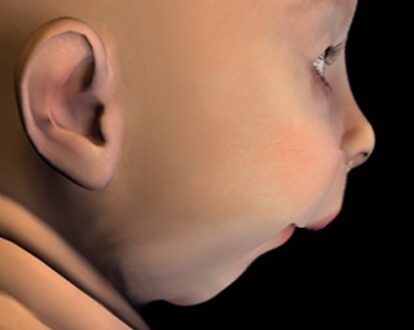Micrognathia is the condition of having a smaller than average jaw. It is common in infants and adolescents and often corrects itself as the person gets older. Micrognathia is more common in newborns than suspected. This anomaly is frequently associated with cleft palate.
Micrognathia or mandibular hypoplasia means a small mandible (lower jaw). It is common in infants, but is usually self-corrected during growth, due to the jaw’s increasing in size. Many times it’s congenital (present from birth) and it appears as part of a syndrome, which is a condition where more than one body system is involved. A syndrome may be inherited (passed down from the parents) or come about spontaneously.
Micrognathia can present as a birth defect in numerous syndromes, including cleft lip, cleft palate, Pierre Robin sequence or syndrome, Stickler’s syndrome, Beckwith-Wiedemann syndrome, hemifacial microsomia, Treacher Collins syndrome and others. A complex syndrome characterized mainly by aural, oral, and mandibular developmental anomalies which may vary from mild to severe and frequently involve one side of the body. Vertebral anomalies, epibulbar epidermoids, mental retardation, and numerous other anomalies are frequently associated. Orofacial anomalies differ from those in mandibulofacial dysostosis which are usually symmetrical. The presence of hypertelorism may indicate aneuploidy.
Those patients who have micrognathia of maxilla may show retracted middle face due to deficiency of middle face or premaxillary area. In true mandibular micrognathia patient looks like having rerusion of chin, steep mandibular angle and deficient chin button. Ultimately, the outlook depends on the condition that caused micrognathia. Babies with certain conditions, such as achondrogenesis or trisomy 13, only live for a short time. Children with conditions such as Pierre Robin syndrome or Treacher Collins syndrome are able to live relatively normal lives with or without treatment.
The survival rate of a child born with Pierre Robin sequence that does not have other problems is high. The most likely cause of death for these children is related to a blocked airway and/or aspiration. The mandible usually has grown sufficiently by 6 to 18 months of age, whether distraction is used or not, so that the airway problem is not as critical of an issue. Distraction may be used later in some children to help make up for ongoing slow growth.
Micrognathia Symptoms
Micrognathia is characterized by an anomaly in the anatomical structure of the lower mandible where the size is abnormally smaller than the rest of the face. The condition is first noticed during infancy and it is usually the mother who gets to notice it first. Some children are born with a very small or recessed lower jaw. In most cases this does not cause any problems at all, but in a small number of infants it can cause serious problems in the first few months of life. This is mostly due to the tongue moving back into the throat when the child breathes in. The tongue then partly or completely blocks the airway. This is known as upper airway obstruction and can cause serious disruption to breathing and feeding. Symptoms of micrognathia can vary from child to child but may include:
- Apneic spells (a temporary stop in breathing during sleep)
- Inability to feed
- Lower jaw is larger than normal resulting in protruded chin.
- Increased maxillary bone volume will result in gummy smile i.e. more amount of gums become visible when patient smiles.
- Prominent Chin button
- Prognathic mandible
- Jaw angle is less steep. Prolonged feeding
- Noisy breathing
- Poor ability to sleep
- Poor weight gain
Micrognathia Causes
Micrognathia can be associated with pituitary gigantism, tumors, and other disorders. Some of the causes of micrognathia are:
- Pierre Robin syndrome
- Wolf-Hirschhorn syndrome
- Cri-du-Chat syndrome
- Trisomy 13 and Trisomy 18
- Progeria
- Treacher Collins syndrome
- Turner syndrome
- Russell-Silver syndrome
- Hallermann-Streiff syndrome
- Fetal alcohol syndrome
- Digeorge syndrome
- Prader-Willi syndrome
- Marfan syndrome
- Noonan syndrome
- Smith-Lemli-Opitz syndrome
- Seckel syndrome
- Juvenile idiopathic arthritis
- Goldenhar syndrome
Micrognathia Treatment
Micrognathia treatment is generally not required except for the underlying cause which may need regular monitoring and treatment. Several adjustments, on the other hand are necessary to help the child thrive, such as using special equipments to feed the child and modifying the eating methods to help feed the child. Micrognathia can often be corrected with surgery. It is also known as prognathic mandible. Corrective surgical procedures can be done by an orthodontist to correct the lower jaw and to align the teeth. Devices such as braces can also help in correcting the misaligned teeth that resulted from the abnormally small size of the jaw.
Micrognathia ICD-10 Code
Micrognathia ICD-10 code is M26.09. M26.09 is a billable/specific ICD-10-CM code that can be used to indicate a diagnosis for reimbursement purposes. This is the American ICD-10-CM version of M26.09. Other international versions of ICD-10 M26.09 may differ.
Micrognathia Pictures
 Health & Care Information
Health & Care Information 



